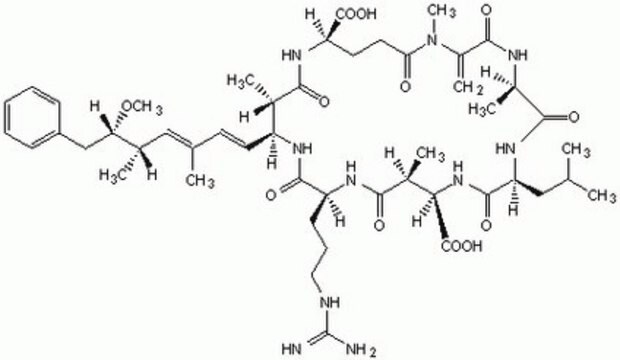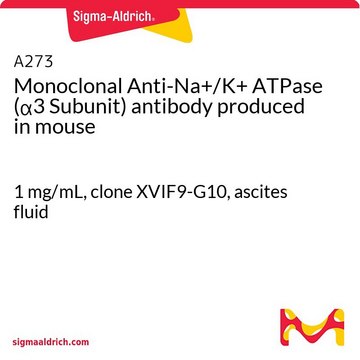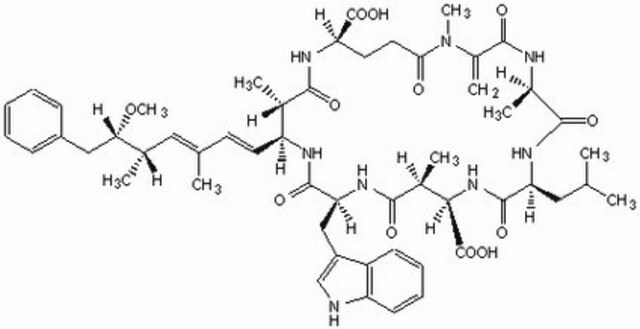A276
Monoclonal Anti-Na+/K+ ATPase (α Subunit) antibody produced in mouse
clone M7-PB-E9, ascites fluid
Synonym(e):
Anti-CMT2DD, Anti-HOMGSMR2
About This Item
Empfohlene Produkte
Biologische Quelle
mouse
Qualitätsniveau
Konjugat
unconjugated
Antikörperform
ascites fluid
Antikörper-Produkttyp
primary antibodies
Klon
M7-PB-E9, monoclonal
Mol-Gew.
antigen ~110 kDa
Speziesreaktivität
canine, chicken, human, sheep, pig, bovine, mouse
Darf nicht reagieren mit
rat, Xenopus
Methode(n)
immunocytochemistry: suitable
immunofluorescence: 1:20
immunohistochemistry (frozen sections): 1:100
immunoprecipitation (IP): suitable
indirect ELISA: suitable
western blot: 1:500-1:5000
Isotyp
IgG1
UniProt-Hinterlegungsnummer
Versandbedingung
dry ice
Lagertemp.
−20°C
Posttranslationale Modifikation Target
unmodified
Angaben zum Gen
human ... ATP1A1(476)
Allgemeine Beschreibung
Immunogen
Anwendung
Biochem./physiol. Wirkung
The different isoforms of the sodium/potassium ATPase exhibit tissue-specific and developmental patterns of expression. The α 1 and β mRNAs are present in all cell types examined, whereas the α 2 and α 3 mRNAs exhibit a more restricted pattern of cell-specific expression. The α subunit has been found in kidney, brain, heart, and to a lesser extent liver, skeletal and smooth muscle.
Zielbeschreibung
Physikalische Form
Haftungsausschluss
Sie haben nicht das passende Produkt gefunden?
Probieren Sie unser Produkt-Auswahlhilfe. aus.
Empfehlung
Lagerklassenschlüssel
13 - Non Combustible Solids
WGK
WGK 1
Flammpunkt (°F)
Not applicable
Flammpunkt (°C)
Not applicable
Persönliche Schutzausrüstung
Eyeshields, Gloves, multi-purpose combination respirator cartridge (US)
Analysenzertifikate (COA)
Suchen Sie nach Analysenzertifikate (COA), indem Sie die Lot-/Chargennummer des Produkts eingeben. Lot- und Chargennummern sind auf dem Produktetikett hinter den Wörtern ‘Lot’ oder ‘Batch’ (Lot oder Charge) zu finden.
Besitzen Sie dieses Produkt bereits?
In der Dokumentenbibliothek finden Sie die Dokumentation zu den Produkten, die Sie kürzlich erworben haben.
Kunden haben sich ebenfalls angesehen
Unser Team von Wissenschaftlern verfügt über Erfahrung in allen Forschungsbereichen einschließlich Life Science, Materialwissenschaften, chemischer Synthese, Chromatographie, Analytik und vielen mehr..
Setzen Sie sich mit dem technischen Dienst in Verbindung.










